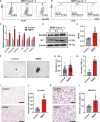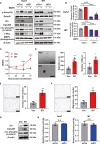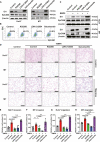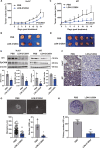BMP9-ID1 signaling promotes EpCAM-positive cancer stem cell properties in hepatocellular carcinoma
- PMID: 33834612
- PMCID: PMC8333780
- DOI: 10.1002/1878-0261.12963
BMP9-ID1 signaling promotes EpCAM-positive cancer stem cell properties in hepatocellular carcinoma
Abstract
The malignant nature of hepatocellular carcinoma (HCC) is closely related to the presence of cancer stem cells (CSCs). Bone morphologic protein 9 (BMP9), a member of the transforming growth factor-beta (TGF-β) superfamily, was recently reported to be involved in liver diseases including cancer. We aimed to elucidate the role of BMP9 signaling in HCC-CSC properties and to assess the therapeutic effect of BMP receptor inhibitors in HCC. We have identified that high BMP9 expression in tumor tissues or serum from patients with HCC leads to poorer outcome. BMP9 promoted CSC properties in epithelial cell adhesion molecule (EpCAM)-positive HCC subtype via enhancing inhibitor of DNA-binding protein 1 (ID1) expression in vitro. Additionally, ID1 knockdown significantly repressed BMP9-promoted HCC-CSC properties by suppressing Wnt/β-catenin signaling. Interestingly, cells treated with BMP receptor inhibitors K02288 and LDN-212854 blocked HCC-CSC activation by inhibiting BMP9-ID1 signaling, in contrast to cells treated with the TGF-β receptor inhibitor galunisertib. Treatment with LDN-212854 suppressed HCC tumor growth by repressing ID1 and EpCAM in vivo. Our study demonstrates the pivotal role of BMP9-ID1 signaling in promoting HCC-CSC properties and the therapeutic potential of BMP receptor inhibitors in treating EpCAM-positive HCC. Therefore, targeting BMP9-ID1 signaling could offer novel therapeutic options for patients with malignant HCC.
Keywords: BMP receptor inhibitor; BMP9-ID1 signaling; EpCAM; cancer stem cells; hepatocellular carcinoma.
© 2021 The Authors. Molecular Oncology published by John Wiley & Sons Ltd on behalf of Federation of European Biochemical Societies.
Conflict of interest statement
The authors declare no conflict of interest.
Figures






Similar articles
-
BMP9-ID1 Signaling Activates HIF-1α and VEGFA Expression to Promote Tumor Angiogenesis in Hepatocellular Carcinoma.Int J Mol Sci. 2022 Jan 27;23(3):1475. doi: 10.3390/ijms23031475. Int J Mol Sci. 2022. PMID: 35163396 Free PMC article.
-
BMP9-ID1 Pathway Attenuates N6-Methyladenosine Levels of CyclinD1 to Promote Cell Proliferation in Hepatocellular Carcinoma.Int J Mol Sci. 2024 Jan 12;25(2):981. doi: 10.3390/ijms25020981. Int J Mol Sci. 2024. PMID: 38256056 Free PMC article.
-
ID1 promotes hepatocellular carcinoma proliferation and confers chemoresistance to oxaliplatin by activating pentose phosphate pathway.J Exp Clin Cancer Res. 2017 Nov 23;36(1):166. doi: 10.1186/s13046-017-0637-7. J Exp Clin Cancer Res. 2017. PMID: 29169374 Free PMC article.
-
Cellular and Molecular Biology of Cancer Stem Cells of Hepatocellular Carcinoma.Int J Mol Sci. 2023 Jan 11;24(2):1417. doi: 10.3390/ijms24021417. Int J Mol Sci. 2023. PMID: 36674932 Free PMC article. Review.
-
Novel therapeutic strategies for targeting liver cancer stem cells.Int J Biol Sci. 2011 Apr 26;7(5):517-35. doi: 10.7150/ijbs.7.517. Int J Biol Sci. 2011. PMID: 21552419 Free PMC article. Review.
Cited by
-
Transcription factor 3 promotes migration and invasion potential and maintains cancer stemness by activating ID1 expression in esophageal squamous cell carcinoma.Cancer Biol Ther. 2023 Dec 31;24(1):2246206. doi: 10.1080/15384047.2023.2246206. Cancer Biol Ther. 2023. PMID: 37607071 Free PMC article.
-
Emerging Regulatory Mechanisms Involved in Liver Cancer Stem Cell Properties in Hepatocellular Carcinoma.Front Cell Dev Biol. 2021 Jul 22;9:691410. doi: 10.3389/fcell.2021.691410. eCollection 2021. Front Cell Dev Biol. 2021. PMID: 34368140 Free PMC article. Review.
-
Unveiling the Impact of BMP9 in Liver Diseases: Insights into Pathogenesis and Therapeutic Potential.Biomolecules. 2024 Aug 15;14(8):1013. doi: 10.3390/biom14081013. Biomolecules. 2024. PMID: 39199400 Free PMC article. Review.
-
KDM4A promotes malignant progression of breast cancer by down-regulating BMP9 inducing consequent enhancement of glutamine metabolism.Cancer Cell Int. 2024 Sep 19;24(1):322. doi: 10.1186/s12935-024-03504-0. Cancer Cell Int. 2024. PMID: 39300582 Free PMC article.
-
Autophagy-mediated ID1 turnover dictates chemo-resistant fate in ovarian cancer stem cells.J Exp Clin Cancer Res. 2024 Aug 10;43(1):222. doi: 10.1186/s13046-024-03147-z. J Exp Clin Cancer Res. 2024. PMID: 39123206 Free PMC article.
References
-
- Elkhenany H, Shekshek A, Abdel‐Daim M & El‐Badri N (2020) Stem cell therapy for hepatocellular carcinoma: future perspectives. Adv Exp Med Biol 1237, 97–119. - PubMed
-
- Visvader JE & Lindeman GJ (2008) Cancer stem cells in solid tumours: accumulating evidence and unresolved questions. Nat Rev Cancer 8, 755–768. - PubMed
Publication types
MeSH terms
Substances
LinkOut - more resources
Full Text Sources
Other Literature Sources
Medical
Research Materials
Miscellaneous

